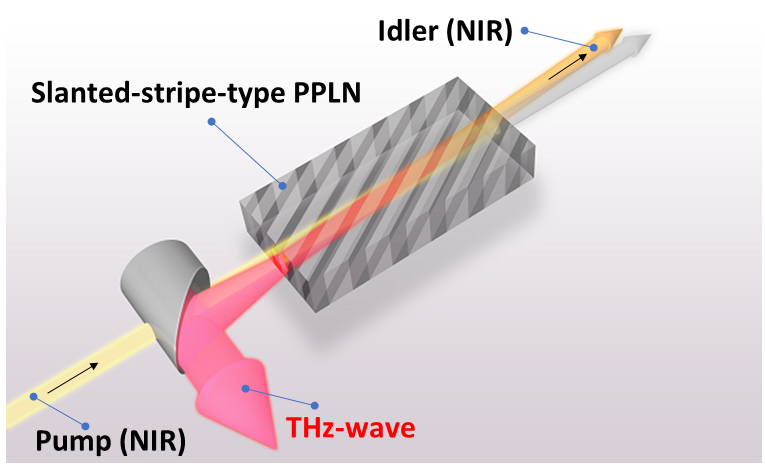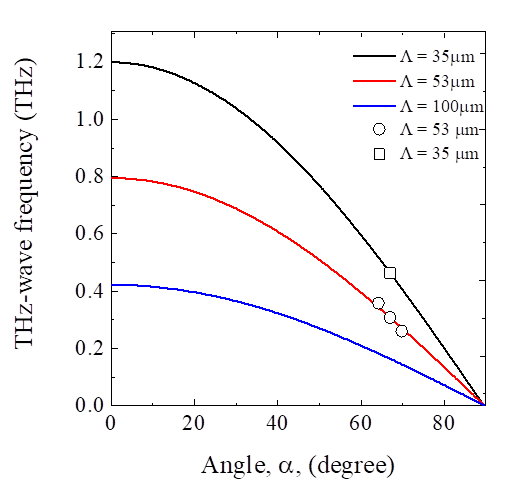Research on frequency-agile ultra-widely tunable THz-wave sources
Backward THz-wave Parametric Oscillator (BW-TPO)
- Demonstration of backward THz-wave parametric oscillator
- Discovery the phase-matching condition and the tunability
- Development of palmtop THz-wave source
- Fine frequency tunability without mode-hopping
We have investigated a phase-matching condition on backward THz-wave parametric oscillation based on nonlinear wavelength conversion and demonstrated THz-wave oscillation without any cavity configurations.
Backward optical parametric oscillation was proposed its basic theory at 1966. The scheme without any cavity configurations has attractive features such as compactness and robustness. A few reports with limited conditions are there actually, but detail mechanism was unclarified.
We designed a slant-stripe-type periodically poled lithium niobate crystal to achieve the backward oscillation. The oscillation demonstrated by just input nearinfrared pump beam as shown in Fig.1. Figure 2 shows the frequency tunability of experimental results and calculation prospects with various poling structures. The tunability can be explained by quasi-collinear phase-matching condition. It is a new scheme of phase-matching condition on nonlinear optics.
A palmtop THz-wave source based on backward-wave oscillation was developed as shown in a inset of Fig. 1. The device is expected to accelerate various THz applications including nondestructive inspection.


Accurate measurement of nonlinear optical coefficients for organic materials
- Ultra-precise processing by using single crystalline diamond for organic nonlinear optical materials
- Precise processing with nm-level surface roughness for arbitrary crystal axis orientations is achieved.
- Full characterization of the nonlinear optical tensor of organic BNA can be possible with high accuracy.
Although organic materials are known for possessing significant optical nonlinearities, the absolute values of such nonlinearities have not been quantified explicitly. For example, second-order nonlinear optical coefficients d11 and d12 of DAST crystals have three- and seven-fold discrepancies, respectively, according to past reports. To determine such d-coefficients accurately, Maker fringe patterns of precisely processed thin slab samples with high-quality optical surfaces should be measured. However, such precise processing of fragile organic materials was difficult.
To process fragile organic crystals precisely, we applied an ultra-high-precision cutting process using a mono-crystalline diamond with a support of ultrahigh precision optics technology team. After several optimizations of the processing parameters, plane-parallel organic BNA thin plates with fine optical surfaces whose roughness of Ra less than 5 nm were obtained successfully as shown in Fig.1. Fig. 2 shows the measured Maker fringe pattern contributed by d33 of the processed BNA. The pattern agrees well with theoretical fitting and d33-value is determined as 221 ± 4 pm/V at 1.064-mm pumping. This d33-value is 15 times larger than that of representative inorganic KTiOPO4 and clearly shows largeness of optical nonlinearity of organic material. Moreover, unknown elements in d-tensor such as d15, d24 and their resonant wavelength-dispersion owing to CT excitation can be also measured successfully. In this way, ultra-precise processing and accurate d-coefficient measurements obtained in this manner are extremely useful for utilizing the potentials of organic materials.


High-peak-output Terahertz-wave generation - Peak power emission comparable to free electron laser in table-top-size system -
- 10kW peak-power emission from injection-seeded terahertz-wave parametric source
- Widely tunable frequency-range approximately from 0.7 to 3 THz
- Flexibly applied to vast and novel terahertz-wave applications brought from compact system
Wavelength conversion in a nonlinear optical crystal is a promising method of generating coherent terahertz-wave radiation due to its wide tunability, high conversion efficiency and room temperature operation. We have been studying parametric frequency-conversion between infrared and terahertz-wave using noncollinear phase matching in MgO:LiNbO3 as terahertz wave generation based on stimulated polariton scattering. The terahertz-wave parametric sources allow building systems that are not only compact, but also operate at room temperature, making them suitable as practical sources.
Figure 1 shows the experimental setup of injection-seeded terahertz-wave parametric generator. The pumping source is a diode end-pumped single-mode microchip Nd3+:YAG laser passively Q-switched by Cr4+:YAG saturable absorber. The pumping beam from the microchip laser is amplified in originally developed amplifiers. The seeding beam from external cavity diode laser is also amplified by an Yb-doped optical fiber amplifier. The noncolinear phase matching condition was optimized by suppression of stimulated Brillouin scattering and nonlinear cascaded process. Consequently, The maximum peak power of terahertz-wave was obtained more than 10 kW of peak power shown in fig.2. And it was possible to tune the wavelength of terahertz wave from 0.7 – 3.0 THz.
We expect that this source will open up new research fields and applications, such as nonlinear terahertz wave optics.


Research on high-sensitive THz-wave detection
Real-time imaging by nonlinear optical frequency up-conversion
- Sensitive THz-wave detection using nonlinear optical frequency up-conversion
- Two-dimensional THz imaging with 60 fps
- Room-temperature operation with high sensitivity
Real-time terahertz (THz) wave imaging has wide applications in areas such as security, industry, biology, medicine, pharmacy, and arts. We developed a real-time, room-temperature THz imaging system by nonlinear optical frequency up-conversion in an organic 4-dimethylamino-N’-methyl-4’-stilbazolium tosylate (DAST) crystal. Nonlinear optical wavelength up-conversion using DAST crystal has some advantages such as availability of collinear phase-matching condition between THz wave and optical beam, high conversion efficiency, and wide frequency tunability.
Figure 1 shows the experimental setup. In the part of THz-wave imaging, the collimated THz-wave was irradiated to the object at the object plane. THz projection image of the object was irradiated on a DAST crystal for up-conversion detection. A near-infrared beam as a pump beam was also irradiated to the DAST crystal. The up-converted signal beam including two-dimensional spatial information was led to an InGaAs CCD camera.
Figure 2 shows an experimental result of the up-conversion imaging and a visible photo of the sample object. Real-time, room-temperature THz imaging with high spatial resolution reaching diffraction limit has been demonstrated. The system can be applied to various applications including security, semiconductor wafer characterization, drug and food inspection, and gas tracing. The nonlinear optical up-conversion detection is promising and broadening THz horizons.


Research on THz-wave applications using frequency-agile THz-wave source
Sensitive detection of THz-wave radiation by nonlinear wavelength conversion
- Detection of THz-wave radiation from continuous-wave resonant tunneling diodes
- 5-nW minimum detection limit at 1.14 THz
- Important step toward real-word THz-wave applications
The sensitive detection of terahertz (THz)-wave radiation from compact sources at room temperature is crucial for real-world THz-wave applications. As an extremely compact THz-wave source, the resonant tunneling diode (RTD) is a promising electronic device operating in the THz-wave region. In this study, we have demonstrated the room-temperature sensitive detection of THz-wave radiation from continuous-wave (CW) RTDs by nonlinear wavelength conversion.
Figure 1(a) and (b) show a photograph of typical RTD module and a schematic experimental setup, respectively. The mixing of an optical pump wave and THz-wave radiation from the RTD module in the nonlinear optical MgO:LiNbO3 crystal gave rise to the generation of optical up-converted wave according to both the energy and momentum conservation laws. Figure 2 shows the measured optical spectra of the pump and up-converted waves with the 1.14-THz RTD module. We achieved a minimum detection limit of CW THz-wave radiation as low as 5 nW at 1.14 THz, corresponding to 2-aJ energy and 2.7×103 photons within the time window of a 0.31-ns pump pulse. Our experimental results demonstrate that the input frequency and power of RTD modules can be calibrated by measuring the output wavelength and energy of up-converted waves, respectively.
Our detection technique can be applied to real-time spectroscopic detection with multi-frequency THz-wave sources because the noncollinear phase-matching realizes simultaneous up-conversion from superposed THz waves to spatially distributed NIR waves to function as a dispersive THz-wave spectrometer. Therefore, this sensitive optical detection for compact THz-wave sources will open up a new opportunity for the realization of real-world THz-wave applications.


Parametric gain measurement of lithium niobate crystal for high-peak-power THz-wave generation
- THz-wave parametric gain via stimulated Raman scattering by phonon-polariton
- Measurement of crystal-length dependence of THz-wave output using surface-coupling configuration
- Physical basis for design and performance enhancement of ultra-bright table-top THz-wave sources
We have experimentally determined the terahertz (THz)-wave parametric gain via stimulated Raman scattering (SRS) by phonon-polariton in lithium niobate crystal. To obtain the frequency dependence of the parametric gain, we measured the crystal-length dependence of the THz-wave output directly and for the first time using a surface-coupling configuration. Our result provides a physical basis for the design and performance enhancement of SRS-based ultra-bright THz-wave sources for various applications.
A comparison between the theoretically predicted and experimentally measured frequency dependence of parametric gain is essential, particularly with regard to the design of SRS-based ultra-bright THz-wave sources. To measure the THz-wave output as a function of crystal length, we here proposed the use of a surface-coupling configuration based on a trapezoidal lithium niobate crystal. Figure 1 shows the measured THz-wave output as a function of crystal length. From this result, the parametric gain and threshold crystal length were determined as shown by the dashed lines and solids arrows, respectively. Figures 2(a) and 2(b) show the frequency dependencies of parametric gain and threshold crystal length. The measured gain profile is in good agreement with the theoretical prediction based on the constant damping model. We also found that the product of the parametric gain and the threshold crystal length is constant throughout the tuning range. Our finding suggests that the THz-wave peak power from table-top setup is scalable to MW level by optimizing the parametric gain and crystal length.


THz spectroscopic database
Construction of spectroscopic database for THz-wave region is extremely important to activate basic research and commercial applications of THz-wave. In cooperation with NICT we have developed THz-wave spectroscopic database, disclosing it online since 2009 (http://www.thzdb.org/). The database covers much variety materials such as living organ tissues, polymer macro molecules, sugar groups, agricultural chemicals, various organic and inorganic materials as shown in Fig. 9(b). Total number of posting data has exceeded 1200. Our database is accessed 3500 times in one year and running as capital THz database because of superior quantity and quality to other databases at overseas site. In addition, our database was adopted as priority subject of Grant-in-Aid for Publication of Scientific Research Result (KAKENHI). Now the database is under reconstruction to be more user-friendly. We also have plan in the near future to expand the database by updating new data offered from outside research institutions.




